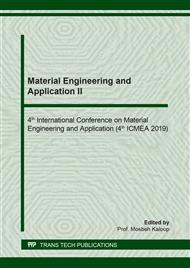[1]
S. Hsu, et al. Uncovering malathion (an organophosphate insecticide) action on Ca+ signal transduction and investigating the effects of BAPTA-AM (a cell permeant Ca2+ chelator) on protective responses in glial cells, Pestic. Biochem. Physiol, 157 (2019) 152-160.
DOI: 10.1016/j.pestbp.2019.03.015
Google Scholar
[2]
J. Lu, et al. Treat of pesticide exposure and related cases in the Philippines, J. Rural Med. 5(2) (2010) 153–64.
Google Scholar
[3]
R. Bala, et al. Ultrasensitive aptamer biosensor for malathion detection based on cationic polymer and gold nanoparticles. Biosens. Bioelectron, 85 (2016) 445–449.
DOI: 10.1016/j.bios.2016.05.042
Google Scholar
[4]
Y. Xie, et al. CuO nanoparticles decorated 3D graphene nanocomposite as non-enzymatic electrochemical sensing platform for malathion detection, J. Electroanal. Chem. 812 (2018) 82–89.
DOI: 10.1016/j.jelechem.2018.01.043
Google Scholar
[5]
D. Huo, et al. A highly efficient organophosphorus pesticide sensor based on CuO nanowires-SWCNT hybrid nanocomposite, Sens. Actuators B. Chem. 199 (2014) 410-417.
DOI: 10.1016/j.snb.2014.04.016
Google Scholar
[6]
A. A. Rowe, et al. CheapStat: An Open-Source, Do-It-Yourself, Potentiostat for Analytical and Educational Applications, PLoS ONE 6(9) (2011) e23783.
DOI: 10.1371/journal.pone.0023783
Google Scholar
[7]
R. Dhanda and M. Kidwai, Magnetically separable CuFe2O4/reduced graphene oxide nanocomposites: as a highly selective catalyst for solvent free oxidative coupling of amines to imines, RSC Adv. 6(58) (2016) 53430-53437.
DOI: 10.1039/c6ra08868f
Google Scholar
[8]
M. Chandel, et al. Synthesis of multifunctional CuFe2O4–reduced graphene oxide nanocomposite: an efficient magnetically separable catalyst as well as high performance supercapacitor and first-principles calculations of its electronic structures, RSC Adv. 8(49) (2018) 27725-27739.
DOI: 10.1039/c8ra05393f
Google Scholar
[9]
L. Achary, et al. Reduced graphene oxide-CuFe2O4 nanocomposite: A highly sensitive room temperature NH3 gas sensor, Sens. Actuators B. Chem. 272 (2018) 100–109.
DOI: 10.1016/j.snb.2018.05.093
Google Scholar
[10]
S. Rouhani, et al. Graphene oxide/CuFe2O4 nanocomposite as a novel scaffold for the immobilization of laccase and its application as a recyclable nanobiocatalyst for the green synthesis of arylsulfonyl benzenediols, Biochem. Eng. J. 133 (2018) 1–11.
DOI: 10.1016/j.bej.2018.01.004
Google Scholar
[11]
M. Huang, et al. Electrochemical nonenzymatic sensor based on CoO decorated reduced graphene oxide for the simultaneous determination of carbofuran and carbaryl in fruits and vegetables, Food Chem. 151 (2014) 191-197.
DOI: 10.1016/j.foodchem.2013.11.046
Google Scholar
[12]
P. Camargo, K. Satyanarayana, and F. Wypych, Nanocomposites: synthesis, structure, properties and new application opportunities. Mat. Res. 12(1) (2009) 1-39.
DOI: 10.1590/s1516-14392009000100002
Google Scholar
[13]
G. Bolat and S. Abaci, Non-Enzymatic Electrochemical Sensing of Malathion Pesticide in Tomato and Apple Samples Based on Gold Nanoparticles-Chitosan-Ionic Liquid Hybrid Nanocomposite. Sens. 18(3) (2018) 773.
DOI: 10.3390/s18030773
Google Scholar
[14]
DENR, Water Quality Guidelines and General Effluent Standards of 2016. DENR Administrative Order 2016-08. (2016).
Google Scholar


